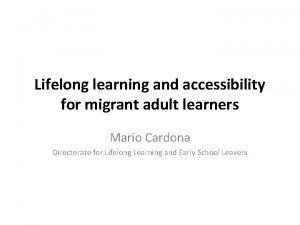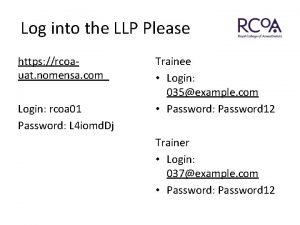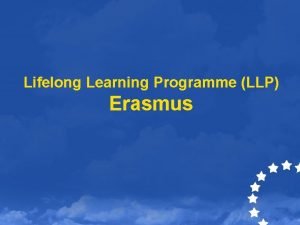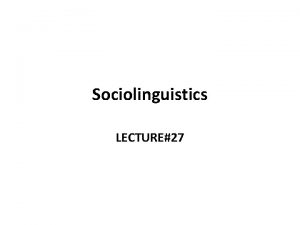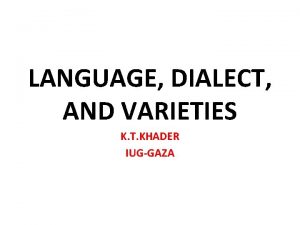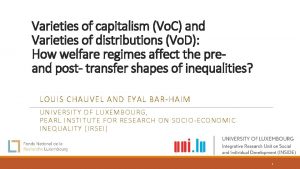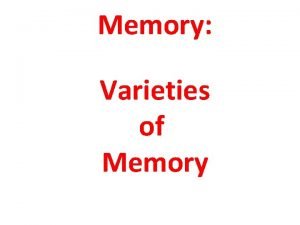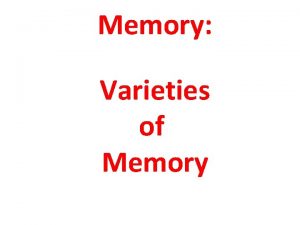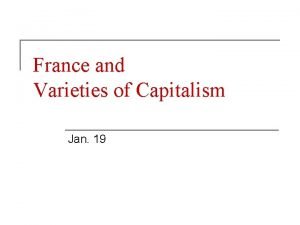Varieties of capitalism and approaches to lifelong learning

















- Slides: 17

Varieties of capitalism and approaches to lifelong learning Contribution to symposium on Lifelong Learning and Social Justice: macro, micro and meso perspectives British Educational Research Association Conference, London Institute of Education, 6 -8 September 2007 Sheila Riddell, Elisabet Weedon, Judith Litjens, Jim Crowther, University of Edinburgh John Holford, University of Nottingham

Three worlds of welfare capitalism (Esping-Andersen, 1989) • the ‘liberal’ welfare state - limited social insurance plan and means tested benefits. Beneficiaries usually lowincome working-class (e. g. United States and United Kingdom); • the ‘conservative-corporatist’ regime - aims to retain existing social hierarchies. Strong emphasis on social insurance (e. g. Belgium, Austria); and • the ‘social-democratic’ regime - aims to promote equality and provide universal benefits. Has a universal insurance scheme but uses some means-testing in provision of benefits (e. g. Norway).

Welfare families (Castles) • English-speaking family (Ireland, UK) • Nordic family • Continental Western European group (France, Germany, Italy, Netherlands) • Southern European group (Greece, Portugal, Spain)

Variants on new European socioeconomic model (Aiginger) • • • Scandinavian Continental Anglo-Saxon Mediterranean Catching-up

Methods of typology development • • Data gathered on range of indicators e. g. GDP & % spent on education Employment rate Employment protection, poverty risk, measures to support disadvantaged • Ed. System characteristics & outcome • Participation in lll • Policies on lll

Table 1: Data contributing to typology of lll

Data sources (see glossary) • Eurostat • Euridyce • EU communications • National Reports

Difficulties in typology development • General problems with welfare state typologies (welfare states & nation states) • Basis for inclusion in particular category • Including new member states • Consistency and reliability of data

Country similarities & differences: broad economic & social indicators • Marked divide in GDP between old & new member states • Less variation in % GDP spent on education – but richest country (Norway) spends highest %) • Highest employment rates: Norway, Scotland • UK & Ireland have least regulated labour markets • Slovenia & Norway have ‘adequate’ measures for disadvantaged • Risk of poverty – greatest in Ireland & UK; least in Norway & Slovenia


Percentage with at least secondary ed: key points • Most systems comprehensive: exceptions Austria & Flanders • Countries grouped closely together – but little variation between old & new member states • Flanders - lowest percentage • Norway – highest percentage


Percentage in formal lll: key points • UK - high proportion if formal lll, followed by Slovenia & Ireland - flexible HE • Austria - relatively low participation (behind Estonia & Lithuania) - rigid HE system • Lowest participation – Bulgaria (also poorest country)


Lll by educational attainment: key points • In all countries, those with higher levels of educational attainment most likely to be involved in lll (formal, non-formal, informal) • Austria appears to have highest participation, but LFS data for 2003 did not include informal learning for all countries

Aiginger’s typology applied to lll (1) • Scandinavian model: Norway - emphasis on human capital, social capital & personal development. High investment in lll combined with regulated labour markets • Anglo-Saxon model: Ireland, Scotland, England – High participation in lll, low labour market regulation, high poverty risk Lll seen as driver of economy & means of combating social exclusion

Aiginger’s typology applied to lll (2) • Continental model: Rigid & stratified education system. Emphasis on lll as creator of human capital, less on social capital Tightly regulated labour market, but little attention to disadvantaged • Catching-up model: Slovenia has many features in common with old member states, particularly emphasis on social inclusion. • Estonia & Lithuania – some features of Baltic states? • Hungary & Czech Republic – reflections of continental model? • Need for much greater focus on developments in Central & Eastern European countries.
 Lifelong learning and critical self-reflection
Lifelong learning and critical self-reflection Market forms of crabs
Market forms of crabs Lifelong learning essay conclusion
Lifelong learning essay conclusion Socialization is a lifelong process through which
Socialization is a lifelong process through which Lifelong learning malta
Lifelong learning malta Adopting lifelong learning
Adopting lifelong learning Cos'è il lifelong learning
Cos'è il lifelong learning Startse university
Startse university Adopting lifelong learning
Adopting lifelong learning Lifelong learning assessment
Lifelong learning assessment Lifelong learning conference 2018
Lifelong learning conference 2018 Lifelong learning cartoon
Lifelong learning cartoon Llp rcoa
Llp rcoa Llp erasmus
Llp erasmus Tim nau
Tim nau Language and dialect in sociolinguistics
Language and dialect in sociolinguistics What is standard variety of language
What is standard variety of language Linguistic varieties and multilingual nations
Linguistic varieties and multilingual nations




